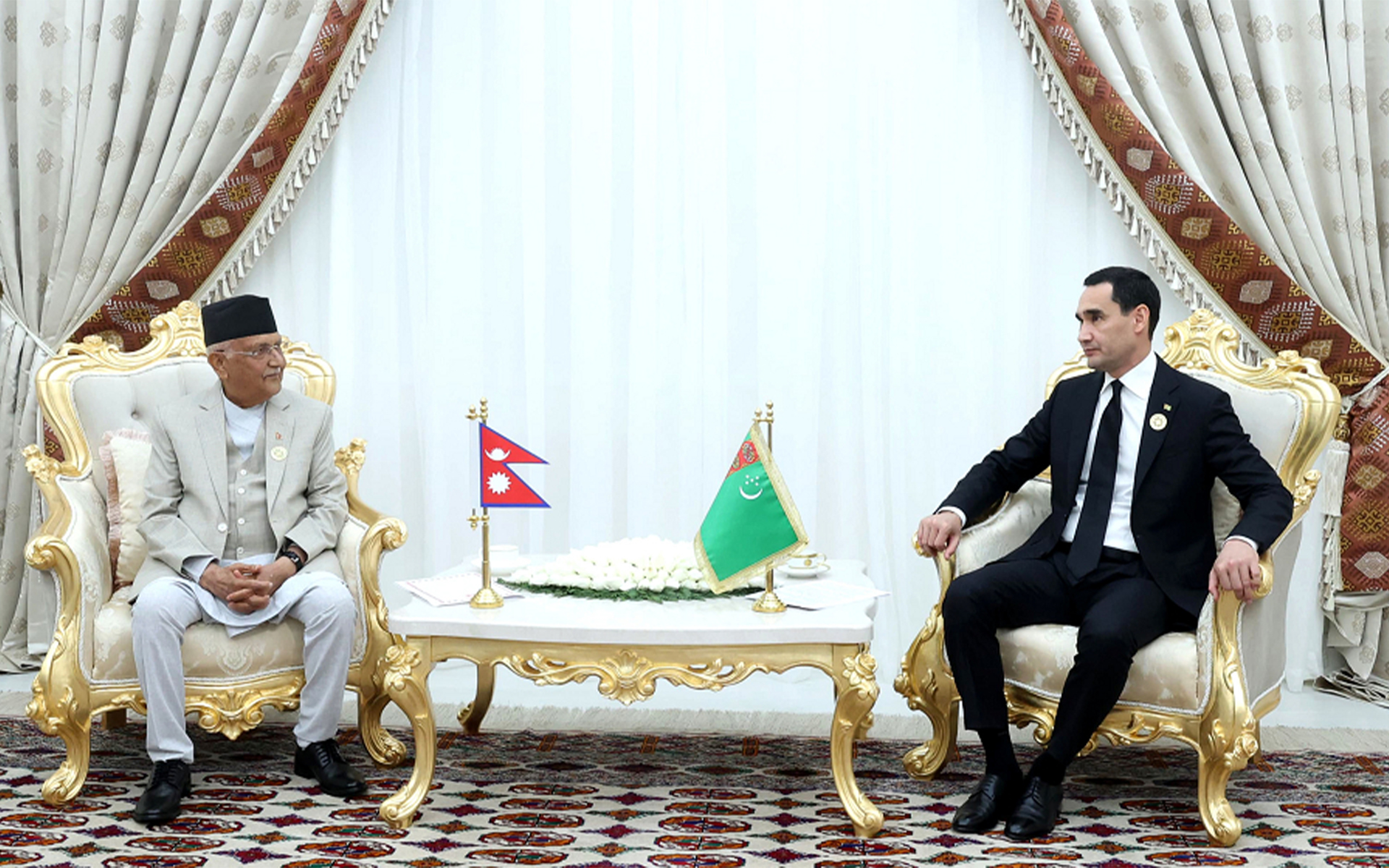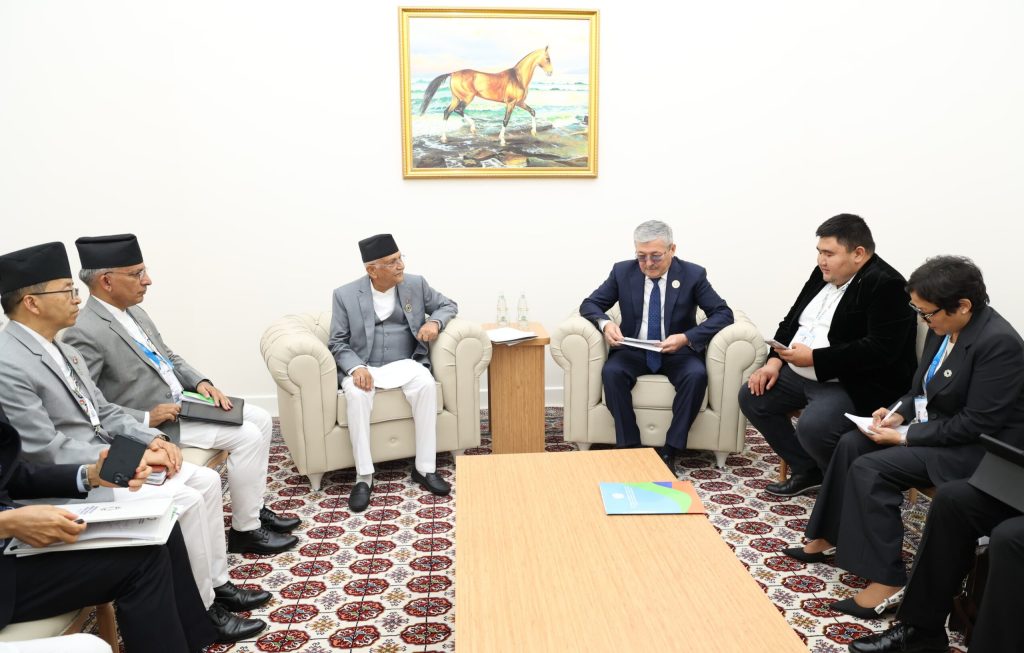
The physical distance between Nepal and the Central Asian countries, Kazakhstan, Kyrgyzstan, Tajikistan, Turkmenistan, and Uzbekistan, is approximately 3,000 kilometers. But in terms of collaboration, interaction, trade, tourism, and high-level exchanges, the distance feels immense.
Travelers from Nepal and the Central Asian countries need to travel via India or another third country. The latest example is Nepal’s Former Prime Minister K. P. Sharma Oli’s visit to the Third United Nations Conference on Landlocked Developing Countries (LLDC3) in Awaza, Turkmenistan. Oli traveled to Awaza via Dubai, UAE, a route significantly longer than a direct flight would be. This logistical hurdle highlights the diplomatic and infrastructural distance between Nepal and these countries.
The Central Asian countries emerged as independent nations after the collapse of the Soviet Union in 1991. Surrounded by powerful neighbors such as Russia, China, Afghanistan, and Pakistan, the region holds immense strategic importance. British geographer Halford Mackinder’s Heartland Theory famously stated, “Who rules Central Asia rules the world.” Great powers have always focused on this region, while Nepal has, until recently, largely overlooked it. Central Asia is not only rich in natural resources such as gold, oil, and gas, but it is also a vital geopolitical arena. China’s Belt and Road Initiative, Russia’s post-Soviet influence, and the United States’ superpower competition all converge here.
Nepal began engaging with Central Asian countries in the 21st century. Diplomatic relations with Kyrgyzstan were established on March 26, 1993, followed by Tajikistan on September 13, 2005, Turkmenistan on October 17, 2005, Kazakhstan on June 30, 2015, and Uzbekistan on January 26, 2018. Strengthening ties with Central Asia will benefit Nepal by providing opportunities to diversify its foreign policy beyond its immediate neighbors and other major powers.
During his visit to Turkmenistan for LLDC3, Oli held a bilateral meeting with President Serdar Berdimuhamedov on the sidelines of the conference on August 6. The two leaders discussed matters of mutual interest and explored ways to strengthen bilateral cooperation, particularly in the context of shared development goals for landlocked countries. The talks also focused on enhancing regional connectivity, economic collaboration, and solidarity among LLDCs.
On the same day, the former PM Oli also met with Adylbek Kasymaliev, Chairman of the Cabinet of Ministers of Kyrgyzstan. The two leaders discussed ways to strengthen economic cooperation between Nepal and the Kyrgyz Republic, among other bilateral matters, according to Nepal’s Ministry of Foreign Affairs.

Earlier, on May 17, Dinara Kemelova, Special Representative of the President of the Kyrgyz Republic for the Implementation of Five Years of Action for Development of Mountain Regions, met with Nepal’s former Foreign Minister, Dr. Arzu Rana Deuba, on the margins of the Sagarmatha Sambaad forum. They discussed matters relating to Nepal–Kyrgyzstan relations, particularly collaboration in areas of climate change, with a focus on sustainability, science, research, innovation, and the mountain agenda, according to the Foreign Ministry.
Kazakhstan, the largest country in Central Asia with a population of approximately 20 million, shares a significant border with Russia. The last notable engagement between Nepal and Kazakhstan was on May 20, 2025, in New Delhi, where Nepal’s Ambassador to India, Shankar Sharma, met with Kazakhstan’s Ambassador to India, Azamat Yeskarayev. Reviewing bilateral ties, the two envoys acknowledged that by 2025, a high level of mutual understanding and active cooperation had been achieved. The meeting also coincided with the 10th anniversary of the establishment of diplomatic relations between Nepal and Kazakhstan.
Ambassador Yeskarayev expressed gratitude to Nepal for co-sponsoring the UN General Assembly resolution on the establishment of the Regional Center on Sustainable Development Goals in Almaty.
According to Nepal’s Embassy in New Delhi, the focus of the meeting was trade and economic cooperation, particularly in transport, logistics, and energy, with an emphasis on international transport corridors and alternative routes. The two sides also discussed the establishment of a Joint Working Group on trade and investment.
At present, both countries are preparing to sign an agreement on a mutual visa-free regime for holders of diplomatic and service passports. An initiative has also been taken to conclude a Memorandum of Cooperation in the field of tourism, considering the growing interest of Kazakh citizens in mountaineering and Nepal’s natural attractions. Moreover, both ambassadors noted prospects for inter-parliamentary cooperation, the development of cultural and tourism exchanges, and steps to simplify visa procedures.
Having established bilateral relations in 2005, Nepal and Tajikistan are yet to significantly deepen their ties for mutual benefit. While diplomatic relations have opened a new chapter, the two countries remain primarily engaged at multilateral levels.
Similarly, Nepal and Uzbekistan are already working closely at the United Nations and other multilateral forums, including as members of the Group of Landlocked Developing Countries and the Non-Aligned Movement. Uzbekistan, the most populous country in Central Asia with around 34.4 million people, has also expressed interest in deepening bilateral cooperation with Nepal. The double-landlocked nation is known for having the world’s fourth-largest gold deposits, as well as rich oil and gas reserves. It is also the largest producer of electricity and a major cotton producer in the region. With cities such as Bukhara and Samarkand, which flourished along the Silk Road, Uzbekistan possesses a diverse and significant cultural heritage.
Geopolitical expert Chandra Dev Bhatta commented that building strong relationships with Central Asian countries is crucial. “I have seen that bilateral engagements are expanding in recent times. It is very important for us to build cordial relations with the Central Asian countries,” he said. Bhatta also noted that since the world is increasingly focused on this region, “why shouldn’t we engage with them and seek benefits in economic and other sectors as well?”